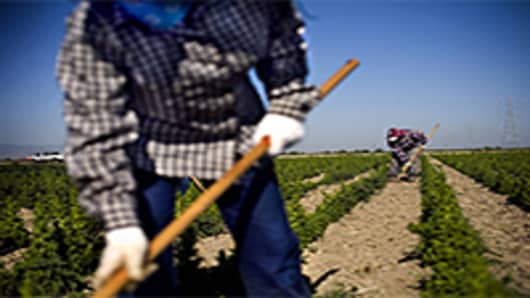The fact is that there is no data whatsoever to support the alleged farm labor crisis. The latest data, issued from the Department of Agriculture on November 27, shows that labor expenses on farms have increased just 0.7 percent over the past year. Costs for hired labor, those who work on the farm long-term, are up just 0.5 percent. Costs for contract labor, the harvest-time pickers, are up just 1.5 percent.
In other words, labor costs are well-below the level of general price inflation. In fact, farm labor costs are still below where they were in 2008 on a nominal basis. In real terms, labor costs are falling for farmers.
This doesn't mean all is well for the farmer. There are genuine challenges and for the first time in years, farm profits seem set to fall this year. The Department of Agriculture is projecting farm revenue to come in at a record $448.5 billion, which is a 4.6 percent gain over last year. But expenses are rising for farms.
The big increases in expenses are the cost of feed (up $12.2 billion, or 13 percent), seed (up $2.1 billion, or 11.9 percent), fertilizer (up $1.6 billion, or 6.3 percent), and pesticides (up $1.1 billion, or 9 percent). These increases dwarf the $200 million increase in labor costs spread across the nation.
If there were a labor shortage, we'd see the price of farm labor rising rapidly. We just don't see that—indicating that there is no shortage at all. There is, instead, a consist cry from the farm lobby for policy makers to adopt policies aimed at lowering labor costs. Gannet reports, for example, that "the American Farm Bureau and other farm groups are working on a plan to present to the new Congress that would allow more migrant laborers to work legally on U.S. farms."
That's what all this noise is really about: enacting policies to crush already low farm wages by allowing farmers to import more foreign workers.
- by CNBC Senior Editor John Carney
Follow John on Twitter. (Market and financial news, adventures in New York City, plus whatever is on his mind.) You can email him at john.carney@nbcuni.com.
We also have two NetNet Twitter feeds. Follow CNBCnetnet for the best of the days posts, including breaking news. Follow NetNetDigest for a feed of every single post each day.
You can also be our friend on Facebook. Or subscribe to John's Facebook page.
We're on Google Plus too! Click here for John's Google page.
Questions? Comments? Tips? Email us at NetNet@cnbc.com or send a text message to: 917-740-8477.
Call us at 201-735-4638.



